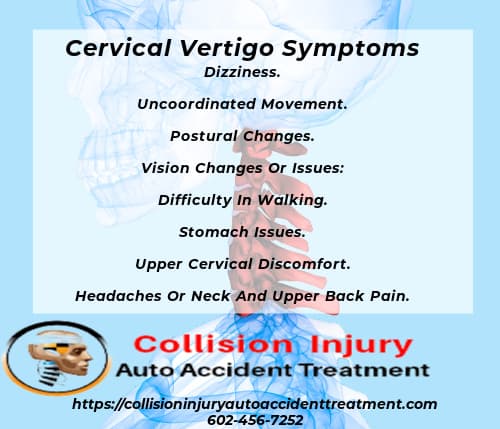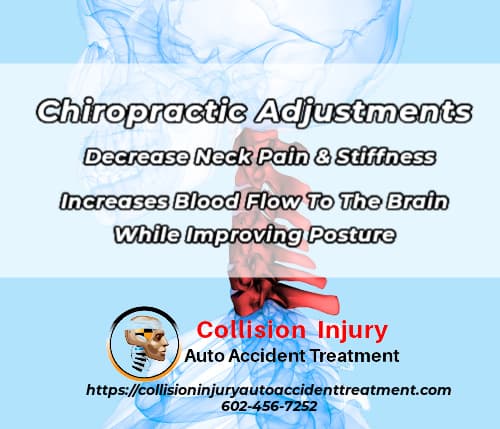Injury victims suffering from whiplash-associated disorders (WAD) may experience vertigo or dizziness on top of more familiar symptoms such as neck stiffness and pain. On the other hand, there is significant debate regarding the connection between vertigo and whiplash-associated disorders. “The Enduring Controversy of Cervicogenic Vertigo and its Place among Positional Vertigo Syndromes” was a meta-analysis published in 2021 by a group of researchers from different countries. A meta-analysis reviews studies that have been published in the past. The report’s authors point out that despite a significant amount of examination and research, few advancements have been made to clarify the disease’s etiology and the underlying mechanisms contributing to its progressive nature. People who have experienced severe head trauma, cervical arthritis, or ruptured disks in the cervical region are more likely to suffer from cervical vertigo. Accidents involving cars frequently result in the kind of whiplash that can cause cervicogenic vertigo.
Cervicogenic Vertigo Is A Condition Characterized By Both Neck Discomfort And Dizziness.
It can also be accompanied by lightheadedness. It is well-recognized that the cervical spine plays a significant role in balance. It is believed that cervicogenic vertigo is produced by a disturbance to the cervical spine or its surrounding tissues. The condition is “cervicogenic,” which suggests that it originates from the cervical spine. A person who suffers from cervicogenic vertigo, often known as a CV, will either have neck symptoms in addition to dizziness or may have a history of a neck injury before the onset of vertigo. One of the problems that the authors point out is that most injuries classified as “neck” injuries involve more than simply the neck alone. The vestibular system is the inner ear system that helps you keep your balance. This system has three semicircular canals filled with fluid and responds to how the head moves. The utricle and saccule are found near the semicircular canals. They sense gravity, back-and-forth movement, the brain itself, the brainstem, the vertebral arteries, and the various spinal ligament structures in the neck and upper back can all be involved in post-WAD vertigo. Whiplash is an excellent example, as it is the most common cause of post-whiplash vertigo.

cervicogenic dizziness chiropractic therapy,
Cervical Vertigo Symptoms Might Vary Significantly. However, The Following Are Among The Most Frequent:
- Dizziness. You may experience feelings of lightheadedness, heaviness, faintness, vertigo, or unsteadiness. Frequently, vertigo disrupts your equilibrium and causes you to tumble, sway, or feel as though you are floating. Since laboratory testing cannot now aid in diagnosing cervical vertigo, other potential types of vertigo will be ruled out; “cervical” vertigo can be distinguished from other types of vertigo since it rarely causes the sensation of spinning in circles.
- Uncoordinated Movement. It is possible that you will be unable to coordinate your movements if you are suffering from cervicogenic dizziness.
- Postural Changes. It is possible that you will discover that you are unable to keep a straight back and an upright posture. Also, you feel like your head is too heavy for your neck to support.
- Vision Changes Or Issues: Cervical vertigo can cause various visual problems. Some examples of this would be excessive blinking, a blurred or distorted view of stationary objects, or the perception of motion even when no actual movement occurs. It’s possible you’ll experience difficulties with reading printed text. Sometimes one can experience dizziness, whereas they feel the room is spinning. On the flip side, one could experience dizziness that is inside their head.
- Difficulty In Walking. When walking, you may experience odd or unusual movements.
- Stomach Issues. It is possible that you could experience feelings of nausea or that you will have the urge to throw up.
- Upper Cervical Discomfort. Many experience pain, but you can merely feel a tightness or discomfort instead.
- Headaches Or Neck And Upper Back Pain. You can experience headaches that feel like pressure building up in the front of your head, like a ring around your head. You may also suffer from severe migraines, making you hypersensitive to sound and light.

cervicogenic dizziness exercises,
Great News Chiropractic Treatment Can Help Decrease Cervicogenic Vertigo
The good news is that chiropractic treatment is quite helpful, although numerous attempts have been made (and have failed) to establish a single diagnostic test that can definitively diagnose vertigo. There is compelling evidence to suggest that spinal manipulation of the neck and midback can be beneficial by stimulating the mechanoreceptors in the ligament insertions and neck muscles. Victims of whiplash injury or whiplash-associated disease vertigo can be relieved to some extent thanks to the vestibular (balance) system and other regions of the brain that receive signals from the facet joint proprioceptors and the muscular spindle cells of the neck muscles. This is because the vestibular (balance) system and other portions of the brain receive and send information via the proprioceptors in the facet joints.
In 2011, a team of Australian researchers found fourteen examinations reporting success in treating vertigo with either a single modality (manual therapy) or a combination of modalities. Their systematic evaluation shows enhancements in vertebrobasilar artery blood flow velocity, muscular discomfort, neck pain, and postural steadiness. Manual manipulative therapy, vestibular rehabilitation (eye exercises), Tai chi, and canal repositioning exercises were all useful in a 2020 systematic analysis of 22 clinical trials, including patients with Cervicogenic vertigo. Chiropractors typically use such techniques and collaborate with other medical professionals in caring for CV patients.

cervicogenic dizziness and anxiety,
Tags: cervicogenic dizziness and anxiety, cervicogenic dizziness chiropractic therapy, cervicogenic dizziness exercises, Cervicogenic Dizziness Symptoms, cervicogenic dizziness treatment, whiplash and cervicogenic dizziness, whiplash and cervicogenic dizziness and anxiety, whiplash and cervicogenic dizziness in Auto Accident, whiplash and cervicogenic dizziness in Car Accident, whiplash and cervicogenic dizziness symptoms, whiplash and cervicogenic dizziness treatment, whiplash and dizziness, whiplash cervicogenic dizziness symptoms Phoenix AZ




